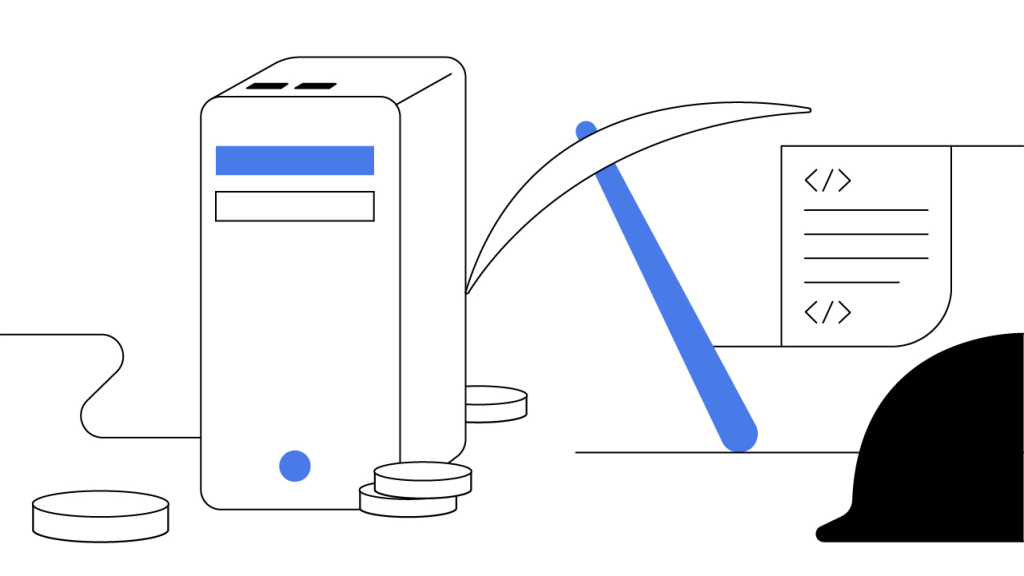Contents
Crypto Mining Rigs Explained: From CPUs to GPUs to ASICs
Crypto mining rigs come in various forms (including CPU, GPU, ASIC, FPGA, and cloud mining) that deliver differing degrees of hashing power and mining rewards.
Updated December 15, 2023 • 8 min read

Summary
The mining of a blockchain’s cryptocurrency is a method to assist in securing a blockchain network from attacks, while financially incentivizing the miners of that network to collaborate in securing it. Mining setups — known colloquially as rigs — can vary in price, size, scale, performance, and efficiency. For example, a mining rig can be a central processing unit (CPU), graphics processing unit (GPU), field-programmable gate array (FPGA), or application-specific integrated circuit (ASIC). Some of the most important factors when considering a crypto mining setup are price, energy consumption, adaptability, and hash rate — or how much computational power the setup can generate toward solving an algorithmic mining problem. Below we cover a few of the the pros and cons of the various crypto miners.
Crypto Mining Rigs Come in Many Types, Shapes, Sizes
The mining of cryptocurrencies refers to the utilization of computer hardware to furnish the computational processes of a blockchain network. Cryptocurrency mining is a way to help secure a blockchain network from attacks, as well as to financially incentivize the miners of that network to assist in securing it. Solve the mining problem for a block, and you can be rewarded with the block reward — typically in the network’s proprietary coin. Crypto miner, mining rig, bitcoin miner, mining hardware — these are just some of the names for the circuits, processors, and computer hardware used to mine cryptocurrencies. While some crypto mining rigs are purpose-built, general-purpose mining rigs (very much like your own computer) can also enable you to take part in mining cryptocurrencies.
Cryptocurrency miners are used on all blockchains that utilize Proof of Work (PoW), which is the consensus mechanism used to securely process, verify, and confirm transactions while hindering double-spending and other blockchain attacks. The most widely known PoW blockchain is Bitcoin, although other established networks such as Ethereum 1.0 also fall into the category. In this article, we’ll look at the varying options for mining cryptocurrencies: from using general-purpose circuitry to bespoke mining hardware. If you’re looking to brush up on your crypto mining basics prior to this deep dive into hardware, read our Bitcoin: Network Security piece.
While mining rigs have various technical features, crypto miners are generally concerned with two above all else: hash rate and energy usage. The hash rate is measured in hashes per second (h/s), and is related to the likelihood of solving the cryptographic puzzle necessary to receive the block or mining reward. Miners also tend to look at how much electricity a mining rig uses, including both its overall energy consumption and its efficiency in terms of hashes per kilowatt-hour. Without enough hashing power and energy efficiency, a miner won’t be profitable and it might actually cost more in electricity costs than any mining rewards you’d receive in return. While some mine simply to support a network’s security and the wider mission of decentralized networks, most crypto miners do it in order to earn a profit.
Is CPU Mining Still Relevant?
CPU mining is using a central processing unit (CPU) to mine cryptocurrency. CPUs can be found in everyday hardware like laptops and desktop computers. However, unless you're reading a crypto mining article from the early 2010s, you likely won’t come across the mention of CPU mining in regards to Bitcoin. That said, in the very early days of bitcoin (BTC) mining, bitcoin miners successfully mined blocks with the CPUs in their laptop and desktop computers. This was possible because there were very few miners at the time, and the overall hash rate was therefore much lower when the Bitcoin network was in its infancy. Less competition meant a higher mining success rate. As the popularity of Bitcoin increased, however, so did the competition, which made mining BTC with readily available CPUs largely obsolete.
Some blockchains feature mining algorithms that have been designed to be CPU-mining friendly, including Bytecoin, Zcash, and Monero. The primary rationale behind this design decision is to allow ordinary retail miners to be able to profitably compete with the large-scale institutional miners that have come to dominate mining on other major blockchains. Besides being more equitable, this also ensures that these projects maintain mining decentralization.
That said, CPU mining is a thing of the past for mining BTC and many large-cap PoW blockchains. In such cases, CPU miners can’t utilize electricity as efficiently, and their hash power can’t compete with other mining rig options. CPU chip mining is measured in kilohashes per second (kh/s), with a kh equaling 1,000 hashes.
GPU Mining Takes Over
As interest in blockchain and crypto has grown, so have the number of miners — and thus the competition for mining rewards. As a result of this cycle, most miners of most large-cap cryptocurrencies have moved on from CPUs and started using graphics processing units (GPUs) to mine cryptocurrency, as these systems tend to be more efficient for mining and have a much better hash rate than CPUs. The first software for GPU mining was released in 2010.
While CPU hash rates are measured in kh/s, GPU hash rates are measured in megahashes per second (mh/s), with 1,000 kilohashes equal to one megahash (a million hashes). Performance varies based on the age and price of the GPU, but many modern GPUs perform in excess of 10 mh/s, with some of the best GPUs approaching 60 mh/s (as of 2021). To put this in context, a 40 mh/s GPU miner has 2,000 times as much hashing power as a 20 kh/s CPU miner. GPU miners achieve these benchmarks because they can process far more operations in parallel than a CPU. On top of this, many miners construct mining rigs that have 6-12 GPUs each, which multiplies their hashing power. Some crypto mining enthusiasts even have multiple multi-GPU mining rigs running, with some home-based operations even reaching up to 24-48 concurrent GPU rigs.
Besides being much faster and more efficient than CPUs, GPUs also have a certain amount of flexibility in being able to mine a variety of coins on different blockchains, with distinct mining algorithms. There are numerous coins that are popular to mine with GPUs, with ether (ETH) being one of the most popular as of 2021. However, with Ethereum’s move to Proof of Stake (PoS), these miners may have to look elsewhere for profitable GPU mining rewards. While the GPU mining of BTC quickly supplanted CPU mining, its reign of mining dominance was also fairly short-lived. By 2015, the mining of BTC was being dominated by a whole new kind of hardware — ASIC miners.
ASIC Miners Take Over Bitcoin (BTC)
Short for application-specific integrated circuit (ASIC), ASIC miners are designed to do one thing and one thing only — mine cryptocurrency. The first ASIC miner was released in 2012, and was about 200 times more powerful than the standard GPU miners of the time. While GPU computing power tends to be measured in mh/s, ASIC mining power is usually measured in terahashes per second (th/s), with one terahash equal to 1,000 megahashes (a trillion hashes). As of 2021, the top ASIC miners can compute 90-100 th/s, which far exceeds the best GPU miners. However, there are some downsides to ASIC miners that have prevented them from dominating the entire crypto mining sector.ASIC miners are expensive, with prices typically ranging from $2,000-15,000 USD. This is a significant cost, and requires some time to attempt reaching a break-even point — and even reaching that point is not guaranteed. With varying scales, electricity costs, and network difficulties, buying ASIC miners could be very profitable — or just very costly. In fact, a large number of ASIC mining operations must be executed at scale to be competitive — with warehouses that may be filled with hundreds or thousands of ASICs. In addition, even the volatility of the cryptocurrency market itself can affect crypto mining profitability, as these mined coins can fluctuate substantially in price, thus affecting the profitability models of costly ASIC rigs and warehouses.
In addition, most ASIC miners are specialized to only mine certain coins, or to only min certain algorithms used by a subset of cryptocurrencies. For example, an ASIC miner optimized for mining bitcoin is optimized for the SHA-256 algorithm Bitcoin uses. Thus, even if a SHA-256 miner could theoretically be used to mine coins that rely on other algorithms, it is usually most cost-effectively deployed in mining a a cryptocurrency that relies on the SHA-256 algorithm — such as BTC of bitcoin cash (BCH). This type of specificity is part of why some blockchain projects are still dominated by GPU miners.
Further, some projects, such as Monero and Ravencoin, are deliberately structured to remain ASIC-resistant (meaning that using any ASIC device is generally not cost-effective). Such structural decisions are fueled in part by a desire to democratize the playing field of the network in question.
However, ASIC miner manufacturers have also released ASIC miners for Litecoin (LTC) and other blockchains that use the same Scrypt algorithm that LTC uses. At least one ASIC miner optimized for Ethereum’s ethash mining algorithm is already on the market, with ethash ASIC miners from other manufacturers scheduled for 2021 releases.
Are FPGA Miners The Best of Both Worlds?
Short for field-programmable gate array (FPGA), FPGA miners are often faster and more efficient than GPUs for most mining algorithms, while maintaining the ability to reconfigure themselves to mine a wide variety of coins — something most ASIC miners cannot do. For this reason, some serious miners consider the FPGA setup the best of both mining worlds, because FPGAs can balance robust hashing power with the flexibility to not be locked into mining a specific coin or algorithm. FPGA miners are called “field-programmable” because they can be programmed or changed “in the field” after they have been delivered to a customer’s preferred destination. The “gate array” refers to the logic gates that can be programmed and optimized for a specific purpose (like crypto mining).
Depending on the FPGA miner and the coin it’s mining, performance can vary widely, ranging from several 100 kh/s to over 20 gigahashes a second (gh/s), with a gigahash equalling a billion hashes. The costs of FPGA miners also have a wide range, with prices that can be anywhere from $200 – 6,000. One downside of FPGA mining is that the setup is generally not as user-friendly as some of the other crypto mining solutions; you may need to design the gate array and the software yourself. You can also download a bitstream or FPGA mining algorithm, which simplifies the setup process, but an FPGA bitstream may charge a developer fee, which could cost up to 8% of your recurring profits.
Cloud Mining: Rig-Free Crypto Mining
Another option for mining is to cloud mine. Much like you can meet your data storage needs by purchasing cloud storage, you can purchase a cloud mining service or contract from a cloud mining provider. This allows you to mine cryptocurrencies indirectly without exposing yourself to as many of the sunk costs and maintenance requirements of specialized mining hardware.
You can typically purchase cloud mining contracts that vary by duration (anywhere from weeks to years) and hash rate. These services can be cost-competitive in many cases, as the cloud mining provider typically has numerous warehouses full of high-efficiency ASIC miners. Another option for cloud mining is to remotely rent the ASIC miners themselves, although this option isn’t nearly as popular as it once was. It gives the cloud miner more flexibility, but generally requires extra setup and maintenance costs — or substantial technical knowledge for those who want to remotely configure the miners themselves.
When demand is up, it may be hard to find available cloud mining options, as these contracts are sometimes sold out. One thing to be vigilant about when trying to cloud mine is to choose a reputable provider. The early days of cloud mining saw a number of crypto scams known as exit scams, where customers paid for contracts in fraudulent companies that ran away with customer money without delivering on their contracts.
Are Crypto Mining Rigs and PoW Blockchains Here To Stay?
Whether relying on GPUs, FPGAs, ASICs, or cloud miners, crypto mining as a whole remains an essential element of the blockchain infrastructure. Despite the proliferation of Proof-of-Stake blockchain networks that eschew the mining process entirely, the demand for popular mineable coins and their associated miners only seems to be going up. It can even be hard to purchase the most popular ASIC miners as they have been constantly sold out, even on the secondary market. The rising hash rates of Bitcoin and other popular PoW blockchain projects is just another sign of how sought-after crypto mining rigs have become.
That being said, for many retail and institutional investors, it’s oftentimes easier — and more profitable — to directly purchase the desired digital assets directly from a centralized exchange (CEX) or decentralized exchange (DEX). Whether you mine cryptocurrency, purchase it directly, or choose a combination of both — is typically a personal decision that is based on your own investment philosophy, time horizon, risk tolerance, technical knowledge, and a variety of other factors.
Cryptopedia does not guarantee the reliability of the Site content and shall not be held liable for any errors, omissions, or inaccuracies. The opinions and views expressed in any Cryptopedia article are solely those of the author(s) and do not reflect the opinions of Gemini or its management. The information provided on the Site is for informational purposes only, and it does not constitute an endorsement of any of the products and services discussed or investment, financial, or trading advice. A qualified professional should be consulted prior to making financial decisions. Please visit our Cryptopedia Site Policy to learn more.

Is this article helpful?


